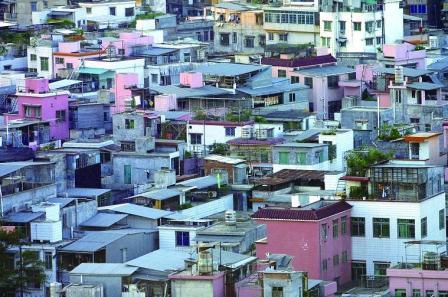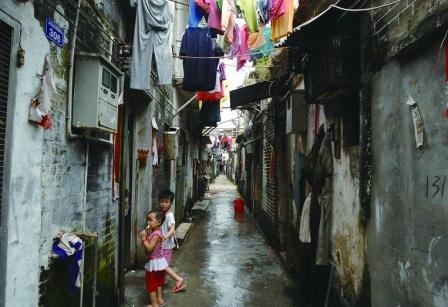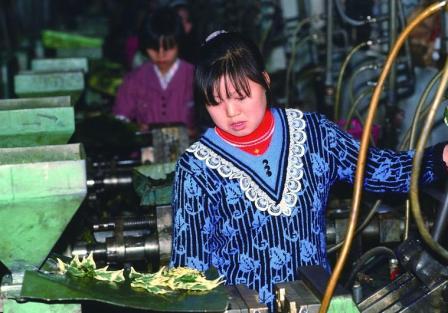Chinese Migrant Workers in Transition - Part I
Cities in the Pearl Delta region were among the first to open-up as China began to transition from a planned to a market economy 30 years ago. In recent years, several municipal governments in the region have been promoting yet another transition -- away from low-end, labor-intensive industries and replace them with high-end production and services.
To support that process, the region is looking for ways to reorganise its demographics in order to develop higher quality human resources.
This special focus looks at how the imminent transition would impact Chinese migrant workers, who formed a significant portion of the region's population. The EO uses case studies in cities like Dongguan and Guangzhou as part I of the focus series.
Part II of the focus features an interview with population management researcher Gao Huayou, who gives insights into a new resident pass system implemented in Dongguan on August 1.
Yangqi: End of Urban Villages
Original article: [Chinese] The existence of Yangqi Village in Guangzhou city is bizarre but understandable. Covering 0.29 square kilometers, this urban village has a population density over 20 times higher than that of the whole of downtown Guangzhou, a developed coastal city in southern China.
The existence of Yangqi Village in Guangzhou city is bizarre but understandable. Covering 0.29 square kilometers, this urban village has a population density over 20 times higher than that of the whole of downtown Guangzhou, a developed coastal city in southern China.
East of the village is the eight-lane Guangzhou Avenue which traverses the city. On the other side of the avenue, high-rise buildings make up Guangzhou's new business district, the Pearl River New Town. South of it is the thriving community Wuyang New Village. North is the ever-bustling Zhongshan First Road. Not far to the west, subway line one shoots ahead underground.
Nestled among all this prosperity, Yangqi is an island jam-packed with shabby buildings. These buildings have a nickname - "hand-shake buildings", as they are so closely nestled that they seem to be shaking hands with each other.
Living here are migrant workers, street vendors, green-horn white collars, and craftsmen. Mostly from rural areas of other provinces, they supply the city with massive cheap labor. In return, Yangqi provides them with cheap living.
One local landlord surnamed Miao told the EO that before the 1990s, Yangqi had some 130 hectares of farmland, with residents earning a living by farming vegetables. At that time, it took him half an hour to ride a tricycle to sell vegetable in downtown Guangzhou, he recalled. Today, instead of vegetable markets, tall buildings flourish in this former farmland.
With the arrival of migrants, Miao's life had become easier—he had stopped working and lived on rents for more than a decade. The inflow of migrants had also spurred 138 urban villages in Guangzhou.
However, the cheap life here would soon end as Guangzhou launched a new round of expansion. To prepare for the Asian Games two years later, the municipal government had planned to appropriate some 1.7 billion to rebuild its old town areas. It's estimated that after reconstruction, housing prices in Yangqi would exceed 10,000 yuan a square meter.
Houjie: Poised for Transition
Original article: [Chinese] Houjie is a town in southwest Dongguan, China's manufacturing hub located between Guangzhou and Hong Kong. The demographic graph here is in the form of a dumbbell, with Taiwanese and Hong Kong entrepreneurs on one end of the weight, and migrant workers from across mainland China on the other end. The 90,000 permanent residents, or 15% of the total population, make up the handle.
Houjie is a town in southwest Dongguan, China's manufacturing hub located between Guangzhou and Hong Kong. The demographic graph here is in the form of a dumbbell, with Taiwanese and Hong Kong entrepreneurs on one end of the weight, and migrant workers from across mainland China on the other end. The 90,000 permanent residents, or 15% of the total population, make up the handle.
The huge migrants population in Houjie has created a "rent economy", which can be divided into three tiers—the village collective which profits by renting land or factories, villagers profiting from collective factory rents and renting out their own houses, and migrants who sublet to others.
Eighty percent of foreign companies in Houjie rent factories, which usually cost over 10 million yuan a year. According to Yin Yuzhou, secretary of one village called Santun, their collective income comes solely from rents.
However, the rent economy wore down people's entrepreneurship and enthusiasm for innovation, which hindered its "double-transition" from a resource-reliant economy to an innovation-based one, and from an elementary-urban society to an advanced one. The double-transition concept was first brought forward by the Dongguan municipal government in January 2007.
The government thus has been encouraging locals to take up occupations or start new businesses. While more locals began working as taxi drivers, security guards, cleaners and waiters, many former housewives were making accessories ordered from nearby factories at home.
Haphazard land-use was another bottleneck. With 44.9% of its land already developed for commercial use, Houjie now planned to reclaim some of the land by reorganizing small and low value-added businesses. The space vacated would be used for trading centers and high value-added companies. However, many believed such reforms were in fact forcing out certain companies and migrant workers.
Bao'an: Slums Reconstructed
Original article: [Chinese] Bao'an district -- benefiting from its strategic location between the locomotive of China's economic reforms, Shenzhen, and the developed Hong Kong -- has over the years wove a remarkable story of wealth creation.
Bao'an district -- benefiting from its strategic location between the locomotive of China's economic reforms, Shenzhen, and the developed Hong Kong -- has over the years wove a remarkable story of wealth creation.
In 2007, its local GDP hit nearly 180 billion yuan, and its urban citizen's per capita disposable income amounted to over 20,000 yuan, even higher than that in some large inland cities.
The prosperity was created largely by the estimated 60,0000 manufaturing enterprises rooted there. Official statistics revealed Bao'an has five million residents, but only 390,000 of them have local household registrations. The rest were mainly less-educated migrant workers attracted by the plentiful job offers in the district.
However, over-population has exerted pressure on the management of its traffic, public security, and public amenities; and thus hindering local social-economic development. The high concentration of low-income migrant workers have also created slums comparable to those that existed in Bombay of India, and Sao Paulo of Brazil.
The slums in Bao'an have been called urban-villages -- poorly equipped and haphazard neighborhoods nestled in city centers. Local officials have long yearned to be rid of these slums, along with the low-end, export-oriented, labor-intensive, and excessive energy-consuming manufacturing plants linked to them.
Since 2004, local government has earmarked some 70 urban-villages for reconstruction, but the progress of these projects have been delayed by demolition obstructions, compensation, and other legal issues.
Some scholars have warned that when processing plants and low-end manufacturing enterprises moved out of Bao'an, the district could fail to develop other replacement economic activities in time, leading to an industrial vacuum and spelling the end of its wealth story. The signs were setting in--in the first half of this year, Bao'an export growth had dropped by 23.03% compared to the same period of last year.
Abridge translation by Zuo Maohong and Liu Peng
- Chinese Migrant Workers in Transition, Part II | 2008-08-05
- Yulin: A Mirage of Wealth | 2008-07-18
- Where Have the Migrant Workers Gone? | 2008-07-18
- Possible Tax Liabilities for Firms Setting Salaries by Fiat | 2008-07-15
- Forty Years of Asian Drama, Part II | 2008-07-04











